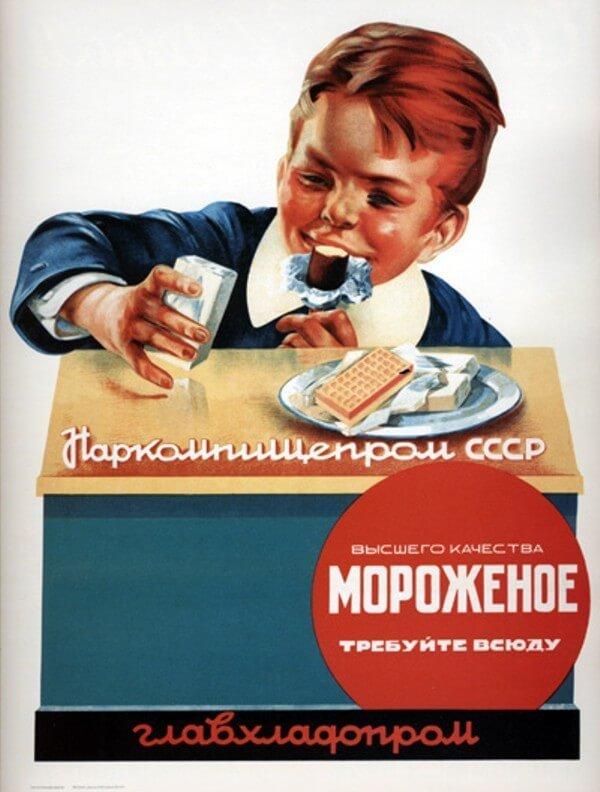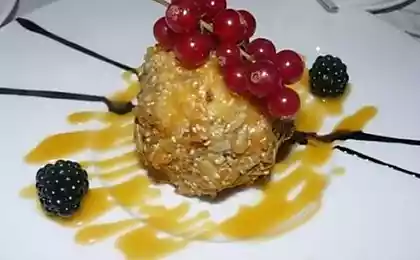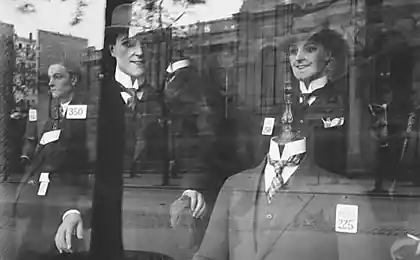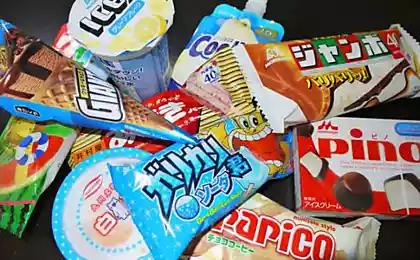578
Ice cream of lilacs: what was the sweet treat before the revolution and how it changed in the Soviet Union
In the hot summer months ice cream is a real way. When the thermometer gets close to around thirty degrees, kiosks selling cold treats storm. Surprised Churchill in 1944 saw in Moscow of people with an appetite absorbing the contents of the waffle cones right in the cold.
If now the ice cream is a universal product, in pre-revolutionary Russia, it was sold only in the warm season. The St. Petersburg newspaper reported in March 1914: "in view of the fact that eating ice cream in cold weather, especially children, may have detrimental effects on health... major General Drachevsky ordered not to allow on the streets selling ice cream until further its resolutions.

In the early XX century ice-cream preferred to work with groups of 10-25 people. Sugar, salt and milk they bought chipped, removed for the summer shed or glacier, rented a truck and every morning went to the streets. In Odessa, the sellers worked with 10-11 hours until late in the evening. Over the summer, every Odessa Iceman could earn 100-150 rubles, which was considered a pretty good amount. In August, many dealers have switched to trade watermelons and seasonal fruits. One of St. Petersburg journalists in 1912, was able to obtain the secrets of the profession from the horse's mouth: "I had to tell the ice cream man that sells in St. Petersburg for over 30 years. He complains that before it was “freer” and “simpler”, a Nona severity went. Here cannot go, there cannot be “scream”... In St. Petersburg, the ice-cream up to 1,000 people. They earn for the season from 300 to 100 rubles, depending on the fly. With a monthly salary of a factory worker in 20-25 rubles figure looks impressive. Earn ice cream in Petersburg came the peasants of the Yaroslavl, Vladimir and Kaluga provinces.

The sanitary state of the industry before the revolution almost did not attend. So, in Orekhovo-Zuyevo the ice-cream man went to work in dirty aprons and sold their goods from the questionable cleanliness of the shell. All day long they wash their plates, destined for customers in the same water. "The buyers of ice-cream is almost exclusively children which eats the dirt from shots or just a piece of dirty newspaper, or of a piece of old dirty books. It would be better to call these sellers carriers of infection." In the Northern capital, police sometimes examined porters, checking the quality of goods and cleanliness of utensils. Despite the absence of factory production, such "artisanal" ice cream was popular and got on pages of books. Igor Severyanin two years before the outbreak of the First world war resolutely rejected the creme brulee and creamy, offering listeners the cream of lilacs. Lilac — lust logo. The purple-coddled rollZald, waterfall heart, fragrant and sweet fluff...andIce cream of lilacs! Ice cream of lilacs!Hey, boy with sbiten, try it! Honest to God, praise, my friend! Even in the 1920-ies ice cream everywhere produced by artisanal craftsmen. Industrial base on manufacturing a cool product transferred only Anastas Mikoyan. In 1936, he goes to the famous American business, and a year later the first Soviet factory mastered the production of ice cream. Capacity for the production of the product appeared in Moscow, Leningrad, Kiev, Kharkov, Poltava, Odessa. Mikoyan believed that the Soviet people should eat at least five pounds of ice cream. Soviet cups were health much flawless before the revolution. All products were sent to bath pasteurizers in stainless steel, in coils supplied with hot water, allowing heat the mixture to 60 degrees and to break up fat lumps. The resulting mixture is placed in special containers and then into the cups. In 1941, the USSR imposed severe GOST regulating the composition of ice cream. The product is made only from whole milk, cream and butter. Ice cream tried to sell during the week. Moscow in late 1930-ies were decorated with posters of Glavkhlopkoprom: "Ice cream demand everywhere!"

For sellers developed a functional and pleasant shape. "The food industry produces high-quality ice cream in various assortments and cream, chocolate, fruity. Besides the usual ice cream sundae made of different varieties and ice cream cake," — declared "the Book about tasty and healthy food". In the Stalin years the ice cream was a strategic product, it maintained the myth of universal affluence and served as a sign of Soviet trade. "There were three — me, Stella and Lola in a Park by a pond in the comfortable chairs. Girls eating ice cream. On the pond swim little ships, full of people, basket of flowers", is a standard excerpt from the diaries of those years. The look is completed with wide promenades, boats, lanterns, colorful kiosks.

During the Second world war the appearance of ice cream was perceived as a kind of indicator of a peaceful life. In August 1941 on the streets of Moscow still sell waffle cone. Vsevolod Vishnevsky wrote in 1944 Leningrad liberated from the blockade: "plant No. 1", Lomolomo" open shop of ice-cream (from five to ten thousand pounds of ice cream a day!)". Ice cream is the indispensable attribute of the celebration of may 9 in the Soviet capital. "Pass — morning people flooded the Red square in the center. Heroes of the Soviet Union caught on the streets, shaking. Hugging, kissing. Some military dragged the boys to ice-cream and feed all the ice cream," — said in the diary Lazar Brontman. At the turn of 1940-1950-ies there appears a new branch of catering, ice cream shops. Rolan Bykov wrote that the employees of the cafe struck up acquaintances through the back door: "Every Muscovite knows ice cream shops on Gorky street, opposite the post office, because it is the only one in all of Moscow. And though I've never been, but the line that always sticks out in front of the doors, daily suggests the fact of its existence". Also interesting: Fried ice cream — unusual and very simple! The USSR in 1958, the History of ice cream is inseparable from the history of humanity for three thousand years. Alexander the great served ice mixed with fruit. Even Napoleon at St. Helena had no magical delicacy. Research shows that do not buy ice cream, only 26% of Russians, and two thirds happy to eat it in winter.published Author: Paul Hilariou, historian macquoid P. S. And remember, only by changing their consumption — together we change the world! ©
Join us in Facebook , Vkontakte, Odnoklassniki
Source: new-retail.ru/magaziny/istoriya/morozhenoe_iz_sireni_kakim_bylo_sladkoe_lakomstvo_do_revolyutsii_i_kak_ono_izmenilos_v_sssr4686/
If now the ice cream is a universal product, in pre-revolutionary Russia, it was sold only in the warm season. The St. Petersburg newspaper reported in March 1914: "in view of the fact that eating ice cream in cold weather, especially children, may have detrimental effects on health... major General Drachevsky ordered not to allow on the streets selling ice cream until further its resolutions.

In the early XX century ice-cream preferred to work with groups of 10-25 people. Sugar, salt and milk they bought chipped, removed for the summer shed or glacier, rented a truck and every morning went to the streets. In Odessa, the sellers worked with 10-11 hours until late in the evening. Over the summer, every Odessa Iceman could earn 100-150 rubles, which was considered a pretty good amount. In August, many dealers have switched to trade watermelons and seasonal fruits. One of St. Petersburg journalists in 1912, was able to obtain the secrets of the profession from the horse's mouth: "I had to tell the ice cream man that sells in St. Petersburg for over 30 years. He complains that before it was “freer” and “simpler”, a Nona severity went. Here cannot go, there cannot be “scream”... In St. Petersburg, the ice-cream up to 1,000 people. They earn for the season from 300 to 100 rubles, depending on the fly. With a monthly salary of a factory worker in 20-25 rubles figure looks impressive. Earn ice cream in Petersburg came the peasants of the Yaroslavl, Vladimir and Kaluga provinces.

The sanitary state of the industry before the revolution almost did not attend. So, in Orekhovo-Zuyevo the ice-cream man went to work in dirty aprons and sold their goods from the questionable cleanliness of the shell. All day long they wash their plates, destined for customers in the same water. "The buyers of ice-cream is almost exclusively children which eats the dirt from shots or just a piece of dirty newspaper, or of a piece of old dirty books. It would be better to call these sellers carriers of infection." In the Northern capital, police sometimes examined porters, checking the quality of goods and cleanliness of utensils. Despite the absence of factory production, such "artisanal" ice cream was popular and got on pages of books. Igor Severyanin two years before the outbreak of the First world war resolutely rejected the creme brulee and creamy, offering listeners the cream of lilacs. Lilac — lust logo. The purple-coddled rollZald, waterfall heart, fragrant and sweet fluff...andIce cream of lilacs! Ice cream of lilacs!Hey, boy with sbiten, try it! Honest to God, praise, my friend! Even in the 1920-ies ice cream everywhere produced by artisanal craftsmen. Industrial base on manufacturing a cool product transferred only Anastas Mikoyan. In 1936, he goes to the famous American business, and a year later the first Soviet factory mastered the production of ice cream. Capacity for the production of the product appeared in Moscow, Leningrad, Kiev, Kharkov, Poltava, Odessa. Mikoyan believed that the Soviet people should eat at least five pounds of ice cream. Soviet cups were health much flawless before the revolution. All products were sent to bath pasteurizers in stainless steel, in coils supplied with hot water, allowing heat the mixture to 60 degrees and to break up fat lumps. The resulting mixture is placed in special containers and then into the cups. In 1941, the USSR imposed severe GOST regulating the composition of ice cream. The product is made only from whole milk, cream and butter. Ice cream tried to sell during the week. Moscow in late 1930-ies were decorated with posters of Glavkhlopkoprom: "Ice cream demand everywhere!"

For sellers developed a functional and pleasant shape. "The food industry produces high-quality ice cream in various assortments and cream, chocolate, fruity. Besides the usual ice cream sundae made of different varieties and ice cream cake," — declared "the Book about tasty and healthy food". In the Stalin years the ice cream was a strategic product, it maintained the myth of universal affluence and served as a sign of Soviet trade. "There were three — me, Stella and Lola in a Park by a pond in the comfortable chairs. Girls eating ice cream. On the pond swim little ships, full of people, basket of flowers", is a standard excerpt from the diaries of those years. The look is completed with wide promenades, boats, lanterns, colorful kiosks.

During the Second world war the appearance of ice cream was perceived as a kind of indicator of a peaceful life. In August 1941 on the streets of Moscow still sell waffle cone. Vsevolod Vishnevsky wrote in 1944 Leningrad liberated from the blockade: "plant No. 1", Lomolomo" open shop of ice-cream (from five to ten thousand pounds of ice cream a day!)". Ice cream is the indispensable attribute of the celebration of may 9 in the Soviet capital. "Pass — morning people flooded the Red square in the center. Heroes of the Soviet Union caught on the streets, shaking. Hugging, kissing. Some military dragged the boys to ice-cream and feed all the ice cream," — said in the diary Lazar Brontman. At the turn of 1940-1950-ies there appears a new branch of catering, ice cream shops. Rolan Bykov wrote that the employees of the cafe struck up acquaintances through the back door: "Every Muscovite knows ice cream shops on Gorky street, opposite the post office, because it is the only one in all of Moscow. And though I've never been, but the line that always sticks out in front of the doors, daily suggests the fact of its existence". Also interesting: Fried ice cream — unusual and very simple! The USSR in 1958, the History of ice cream is inseparable from the history of humanity for three thousand years. Alexander the great served ice mixed with fruit. Even Napoleon at St. Helena had no magical delicacy. Research shows that do not buy ice cream, only 26% of Russians, and two thirds happy to eat it in winter.published Author: Paul Hilariou, historian macquoid P. S. And remember, only by changing their consumption — together we change the world! ©
Join us in Facebook , Vkontakte, Odnoklassniki
Source: new-retail.ru/magaziny/istoriya/morozhenoe_iz_sireni_kakim_bylo_sladkoe_lakomstvo_do_revolyutsii_i_kak_ono_izmenilos_v_sssr4686/























